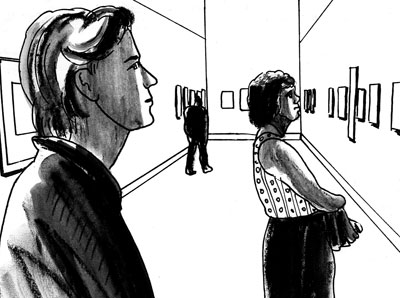 Every Saturday, we’ll be posting a new illustration by David Lester. The Mecca Normal guitarist is visually documenting people, places and events from his band’s 28-year run, with text by vocalist Jean Smith.
Every Saturday, we’ll be posting a new illustration by David Lester. The Mecca Normal guitarist is visually documenting people, places and events from his band’s 28-year run, with text by vocalist Jean Smith.
The four painters were hoping that an imaginative art critic would attach a group moniker to their output, but nothing like that seemed even close to happening. The small shows they’d organized and promoted were ignored by the press. These were labor intensive events that involved transporting paintings to cafes and clothing stores on Commercial Drive or group shows in run-down rehearsal spaces with plugged toilets and leaky ceilings where musicians performed for friends. Their self-penned press releases tried to pass them off as a group of political artists with an appropriate amount of reverence for cultural associations that harked back to abstract expressionism in the ’50s and ’60s in New York, but they were clearly of no interest to local art critics. And really, painters should be painting, not lugging their work around town for stoned students to lean against while tripping out to the latest configuration of improvised free noise made with African hand drums, flutes and badly tuned electric guitars or pushing press releases under the noses of art critics writing for entertainment newspapers.
The very act of conniving to attract attention to their work made them unimportant. Musicians were expected to develop the cult of personality with rock ‘n’ roll affectations and bad behavior. Writers were obnoxious assholes who drunkenly pontificated in bars. Painters, if they were any damn good, would have been discovered already. Painters were supposed to paint quietly until someone noticed what they were up to. Clearly the four of them had no clout and if they continued to bleat about the political nature of their art and the association they made to important accomplishments in the middle of the previous century, they were in serious danger of never getting any press at all. At least they were aware of the existing prejudice, the dynamic they were flailing within.
The thought of bypassing reviews and shows to open a museum intrigued them, but at that point, sitting around the Japanese joint semi-smashed on sake, Jeff, Adam, Bruce and Mark had no idea that another avenue to success was opening up for them. Their names were sizzling like downed power lines during a midnight ice storm, jpegs of their paintings were being circulated and lauded as the next big thing. They were being taken very seriously by an art critic writing a piece for Artforum magazine; they were going to be offered exposure on the world’s most prestigious art stage: New York, New York.
Their big break was in motion, while they discussed the museum as a way to feel better about their lack of progress with commercial galleries, the press or the development of a client base. They lacked customers. Adam joked that he would apply for funding from the Canada Council for the Arts, and everyone laughed. Bruce suggested they spend a few hundred bucks and hire a publicist to make sure they got people out to the opening. They took a vote. Everyone agreed. Meeting adjourned.






